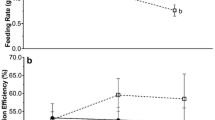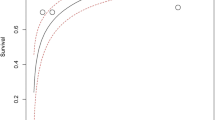Abstract
The sea urchin Lytechinus variegatus is capable of surviving chronic exposure to sodium phosphate (inorganic phosphate) concentrations as high as 3.2 mg l−1, and triethyl phosphate (organic phosphate) concentrations of 1,000 mg l−1. However, chronic exposure to low (0.8 mg l−1 inorganic and 10 mg l−1 organic phosphate), medium (1.6 mg l−1 inorganic and 100 mg l−1 organic phosphate) or high (3.2 mg l−1 inorganic and 1,000 mg l−1 organic phosphate) sublethal concentrations of these phosphates inhibits feeding, fecal production, nutrient absorption and allocation, growth and righting behavior. Food consumption and fecal production declined significantly in individuals exposed to medium and high concentrations of inorganic phosphates and all levels of organic phosphates. Feeding absorption efficiencies for total organics and carbohydrates decreased significantly in individuals held in the highest concentration of organic phosphate. Feeding absorption efficiencies for lipids were significantly reduced in the highest inorganic phosphate concentration only, while they decreased significantly for protein with increasing phosphate exposure. Carbohydrate and lipid levels in gonad and gut tissues decreased significantly with exposure to increasing phosphate concentrations, potentially impairing both gametogenesis and nutrient storage in the gut. Moreover, gonad indices significantly decreased in individuals exposed to the highest concentrations of either phosphate. Growth rates decreased significantly under the influence of all phosphate concentrations, while increasing in seawater alone. Individuals exposed to increasing phosphate concentrations showed reduced righting responses (a measure of stress) and no acclimation in righting times during chronic exposure to phosphates over a 4 week period. These findings indicate that shallow-water populations of L. variegatus subjected to inorganic and organic phosphate pollutants will exhibit stress and be inhibited in their growth and performance due to reductions in feeding, nutrient absorption and allocation of nutrients to key somatic and reproductive tissues.
Similar content being viewed by others
Author information
Authors and Affiliations
Additional information
Received: 10 April 2000 / Accepted: 2 October 2000
Rights and permissions
About this article
Cite this article
Böttger, S., McClintock, J. & Klinger, T. Effects of inorganic and organic phosphates on feeding, feeding absorption, nutrient allocation, growth and righting responses of the sea urchin Lytechinus variegatus. Marine Biology 138, 741–751 (2001). https://doi.org/10.1007/s002270000476
Issue Date:
DOI: https://doi.org/10.1007/s002270000476




